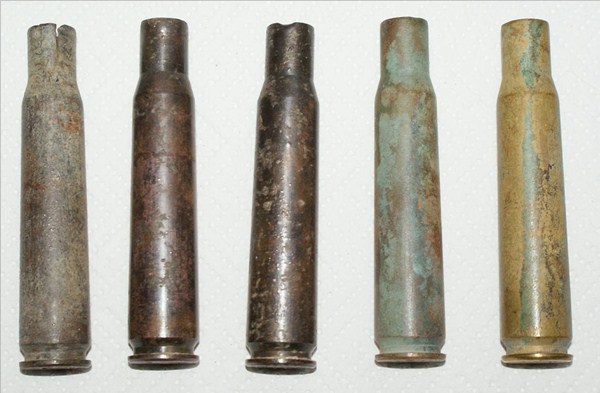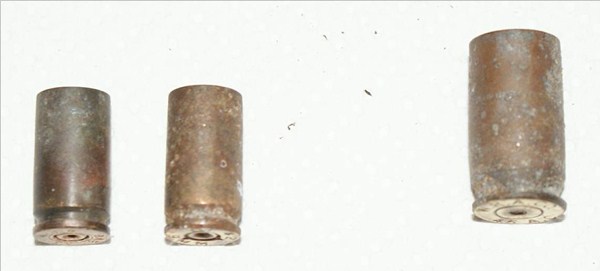How to Read Marking on Fired Shell Casing
Make a one-time donation
I don't accuse for viewing this website or downloading the content, but it does cost me money to host it! If you find the content useful, please feel free to help out with the costs 🙂 No pressure though…….
Or enter a custom amount
Your contribution is appreciated.
Donate
Identification of cartridge cases is important for whatever collector of WW2 ordnance. A basic knowledge of terminology will assistance a collector identify the calibre, origins and apply of a cartridge example.
Start off, general terminology.

As you tin can encounter from the above diagram, there are a number of terms that collectors use when referring to cartridge cases. The most of import of these are the neck, shoulder, rim and head. All of these tin can give vital clues to identifying a cartridge instance. The cervix tin give an approximate calibre, (although the diameter within the mouth is more accurate), and the slope of the shoulder can differentiate between similar cartridge cases (e.g. 20mm Oerlikon has a much longer more graduated shoulder than 20mm Hispano-Suiza).

Every bit this 2nd diagram shows, the bullet is the projectile that leaves the weapon at loftier speed when the cartridge is fired. A cartridge case should never be called a bullet! It is simply NOT correct! The bullet itself has a core and a jacket, along with a groove called a cannelure. This can likewise aid ID certain bullets.
Apart from the headstamp itself, (the mark on the base of a cartridge case), the rim is perchance the nigh of import. In that location are various types of rim.

This terminology looks, at beginning glance, to be a little complicated. However, it really isn't! A rimmed cartridge is called that because the very lesser portion of the head, the 'rim', is wider than the main torso of the cartridge. With a rimless cartridge case, the rim is exactly the same diameter as the cartridge case, which starts in a higher place the extraction groove. Semi-rimmed cartridge cases accept an extraction groove and a rim very slightly larger than the diameter of the cartridge case. Belted cartridge cases take a thicker 'belt' positioned simply above the extraction groove, and rebated cases accept a rim that is smaller in diameter than the cartridge instance.
As for the headstamps themselves, (the markings on the head of the cartridge example), these can give all sorts of information about calibre, manufacturer, year of manufacture, cartridge fill up, cartridge blazon, (e.m. Armour Piercing (AP), Incendiary (I), Armour Piercing Incendiary (API), Tracer (T)), 'mark' of cartridge and even the blazon of blend used to make the cartridge case.
You may find it easier to lookout man a video on this subject instead, so here is one I fabricated a few months back. If non, keep scrolling down…..
To start with, here are the main centrolineal small arms cartridges lined upwards and so yous can run across the departure in overall shape and size. Accept detail note of the difference between a standard 30calibre American cartridge and the British 303. Besides notation the deviation between the standard 30calibre and the M1 Carbine cartridge (this is not alive by the way! I remade it from a spent cartridge case and bullet found separately).

Ok, on to identifying Allied small artillery headstamps.
We'll start with 20mm Hispano-Suiza cannon cartridges. A view of three cartridges establish on various WW2 airbases.

Ok. Let'southward wait at the headstamps. Y'all tin can meet they all follow the same pattern. A letter of the alphabet 'code' which represents the manufacturer, a date postage stamp and a calibre. The right hand case therefore is made by RG (Royal Ordnance Manufactory, Radway Green, Britain), in 1942. The middle case was made by I.C.I. , otherwise known as Kynoch in Standish, UK which is represented by the K2, in 1944.

Also, you lot may accept noticed the chunks cut into the rim of the cartridge. This is not modern damage but damage caused by the breech block forcing the cartridge into the breech so extracting information technology again every bit the gun cycles.
With American cartridges, the headstamps are unremarkably very short, precipitous and sweetness ! Take for example these fifty calibre cartridges, again establish on diverse airbases around the U.k..


The headstamps on these are not as detailed equally some. Usually you lot get the manufacturer 'code' and the last two digits of the twelvemonth, EXCEPT in the example of 1944 which is always represented by a unmarried '4'. So on these cartridges you have RA 43, TW 43, LC 43, SL 4 and DM iv. RA is Remington Artillery Company, TW is Twin Cities ordnance constitute, LC is Lake City Ammunition Plant, SL is St Louis Ordnance Establish and DM is Des Moines Ordnance Establish.
These headstamps are repeated in standard 30 calibre and Carbine rounds. Accept for instance these thirty calibre cartridges, constitute on Slapton Sands.The headstamps all follow the aforementioned principals as the 50 cal cartridges.


British cartridges tended to be a trivial more verbose. Take for case these cartridges, all establish on an old D-Twenty-four hours exercise beach.


The headstamps, every bit yous can see, incorporate a little more information. We still accept the manufacturer 'code' and the year of manufacture (as either 2 or 4 digit), just we too regularly meet 'Seven' which denotes it is a standard Marker Vii cartridge, and in some instances '303' which plainly denotes the calibre. Different Roman numerals announce different 'marks' of cartridge. You may also see the marks 'Z' or IZ' which announce the type of cordite/pulverisation used. 303 cartridge cases tin besides accept lettering to show the blazon of cartridge, for example a B would indicate incendiary.
It is interesting to note that the concluding three cartridges all take the same 'odd' shaped firing pin marker. This elongated mark is made past the firing pivot of a Bren gun. A Lee-Enfield makes the 'dot' mark in the left paw 2 cartridges. And then not only does the headstamp tell united states of america something, fifty-fifty the firing pivot marker can !
Now let's look at 9mm and .45 calibre cartridges, over again found on a D-Solar day practice beach.


Now yous can see a design emerging ! Hopefully you can at present decide what the headstamps hateful when you look at them. You take the manufacturer code, the year postage and the calibre………….It's easy once you know what you're looking at !
The Germans used a petty more complicated system than the Americans and British. Take for case these 7.92 calibre cartridges, all are 'safe' and were bought off a guy in an antiques place for 20p each ! He didn't know what they were but I did because of a basic knowledge of headstamps. The cartridge cases take been married back with a bullet to be fabricated whole, but all are empty and have used percussion caps.


Ok…..all German 7.92 calibre cartridges carry iv stamps. As you expect at the movie, at 12 o'clock is the manufacturers lawmaking. At 3 o'clock is a code with a combination of a roman numeral (I to XXII) for the steel mill supplying the bones case-metal, a lower-case letter for the plating agency and an arabic numeral (ane, two, 3, four, vi, viii, 9, 10, 11, 12, fifteen or 17) for the steel-analysis, which all identifies a copper-plated steel case. In some cases y'all may see a code such as St or St+ or S*. St stands for steel casing either lacquered or phosphated. St+ stands for improved steel casing lacquered or phosphated. * or S* indicates a brass case. At half-dozen o'clock is a batch number and at 9 o'clock is the year of industry represented past the last 2 digits of the twelvemonth. Of interest is the fact that the Germans changed their manufacturer lawmaking system. Between 1937 and 1941 they used the P codes (Patronenfabrik Nummer). Between 1940 and 1945 (at that place was some overlap between the change of coding) they switched to a letter lawmaking and ditched the 'P' number. This means all 'P' coded cartridges are made prior to 1941, and all letter of the alphabet lawmaking cartridges are made from 1940.
So, for example, the far left cartridge was made by cg (Finower Industrie GmbH, Finow/Mark, Brandenburg), the case was made of St+ (steel case, plated), a batch number of 'half-dozen' (yes….i got it wrong on the picture !!! Information technology's a 6 non a 9 ), and a year of 1942.
The far right mitt case is made by P490 ( Hugo Schneider A.G., Werk Altenburg), the steel manufacturing plant code Nine (Baronial-Thyssen-Hutte A.G., Duisburg-Hamborn), the plating firm code westward, (Hugo Schneider A.One thousand. Messingwerke, Taucha-Leipzig), and the steel composition 1. The batch number is 7 and it was made in 1939.
I hope this of utilise to some of yous. I know many volition already know it but it'southward skilful to pass on this sort of data !
payneounkentoot1954.blogspot.com
Source: https://stephentaylorhistorian.com/2017/10/28/cartridge-case-terminology-and-identification/
Post a Comment for "How to Read Marking on Fired Shell Casing"